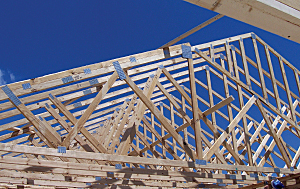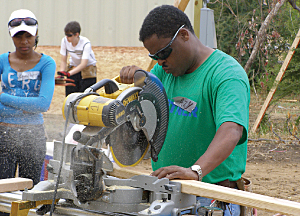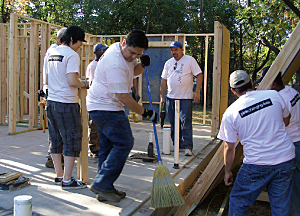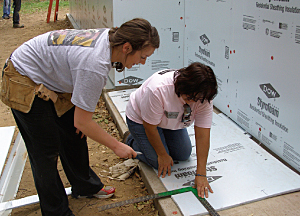ArcUser
Winter 2012 Edition
Habinomics
Looking at need and affordable housing potential
By Karen Richardson, Esri Writer
 This article as a PDF.
This article as a PDF.
Dallas Area Habitat for Humanity is looking for areas with low family incomes and a high percentage of renters, and Esri Community Analyst is helping in this search.
"These hardworking families often have no choice but to spend unsustainable levels—frequently 50 percent of their income or more—on housing," said Bill Hall, CEO of Dallas Area Habitat for Humanity.
The local chapter of this international nonprofit organization, which is headquartered in Atlanta, Georgia, has a mission to eliminate poverty and homelessness from the world. Each year Dallas Habitat provides low-income families in the area with affordable housing options.
Local chapters of Habitat assess levels of need by evaluating income based on family size and monthly budget. Households strapped because a large percentage of monthly income is spent on housing find it difficult to pay for other basic necessities such as food, health care, and clothing. Many times, these families find themselves living in dangerous conditions in substandard housing. Any unexpected expense or the loss of a job can make it impossible to pay rent or make a mortgage payment. These families may be forced to leave their homes and live in unstable transitional housing or on the streets.
 To answer the question, "Where are low-income areas with a high percentage of renters located in Dallas?" Jane Massey, director of neighborhood research and revitalization for Habitat, knew she needed census data for the county for her analyses. Massey was familiar with the organization's use of GIS. She thought that finding this information and presenting it in a map would be the best way to show areas that matched these criteria.
To answer the question, "Where are low-income areas with a high percentage of renters located in Dallas?" Jane Massey, director of neighborhood research and revitalization for Habitat, knew she needed census data for the county for her analyses. Massey was familiar with the organization's use of GIS. She thought that finding this information and presenting it in a map would be the best way to show areas that matched these criteria.
Dallas Habitat had been using ArcGIS in-house for about a year to create map books for advocacy planning. Prior to this, a local Catholic high school, Bishop Dunne, had provided mapping services for them.
The map books, made available to city council members, display parcel boundaries in each city council member's district as well as identify parcels that have poor condition ratings based on the Dallas Central Appraisal District condition codes used for property tax valuations. Using these map books, Dallas Habitat staff hoped to show the city council where problem properties are located to focus the community's response to neighborhood blight.
 Under Massey's direction, Dallas Habitat acquired an Esri Community Analyst license. This Software as a Service (SaaS) mapping solution includes both GIS capabilities and access to thousands of demographic, health, economic, education, and business data variables. Community Analyst also provides access to the most current census data, including American Community Survey (ACS) data. ACS data provides much of the information traditionally furnished by the decennial census but is updated and released more frequently.
Under Massey's direction, Dallas Habitat acquired an Esri Community Analyst license. This Software as a Service (SaaS) mapping solution includes both GIS capabilities and access to thousands of demographic, health, economic, education, and business data variables. Community Analyst also provides access to the most current census data, including American Community Survey (ACS) data. ACS data provides much of the information traditionally furnished by the decennial census but is updated and released more frequently.
Using Community Analyst, Massey quickly downloaded the census data she needed. With the help of Brookhaven Community College student intern David Guthmueller, Dallas Habitat was able to easily create the requested maps. The initial map was created in just five minutes. Guthmueller used Smart Map Search, which allowed him to find the two variables—low income and high percentage of renters—and display them by census tract.
"By simply having access to this data through an easy-to-use mapping interface, we were able to model different scenarios and look at the need level in many communities around Dallas County," said Massey.
 Finding qualified families with Community Analyst allows Dallas Habitat to streamline its efforts and provide services to the people who need it. Over its 25 years of operation, Dallas Habitat has helped a thousand families become homeowners by providing houses at below cost with no cash down payment and a zero percentage mortgage for 25 years. In lieu of a down payment, homeowners are required to contribute 400 hours of sweat equity building their own homes and those of their neighbors. This saves first-time home buyers more than $90,000 over the duration of the loan. Money that used to go toward high housing costs can now go to basic necessities.
Finding qualified families with Community Analyst allows Dallas Habitat to streamline its efforts and provide services to the people who need it. Over its 25 years of operation, Dallas Habitat has helped a thousand families become homeowners by providing houses at below cost with no cash down payment and a zero percentage mortgage for 25 years. In lieu of a down payment, homeowners are required to contribute 400 hours of sweat equity building their own homes and those of their neighbors. This saves first-time home buyers more than $90,000 over the duration of the loan. Money that used to go toward high housing costs can now go to basic necessities.
By bringing together both public and private funding and thousands of volunteers, Dallas Habitat is addressing the affordable housing crisis in Dallas. More than 9,000 volunteers each year donate their time and skills. They contribute more than $1.8 million in value to the community, an innovative model referred to as "Habinomics" by the Dallas Habitat staff.
Massey explains that today staff members wouldn't dream of walking into a meeting without a map. From presenting information to potential donors to determining the best sites for homes, GIS is a key part of the organization's effort to develop communities throughout the Dallas area.